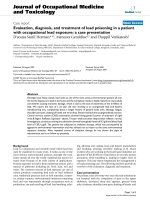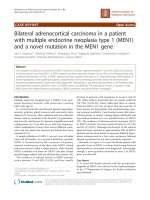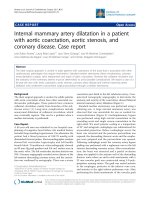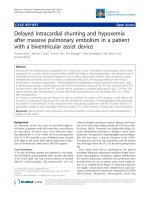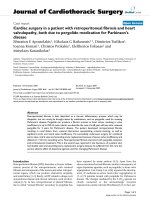Reduced anogenital distance, hematuria and left renal hypoplasia in a patient with 13q33.1–34 deletion: Case report and literature review
Bạn đang xem bản rút gọn của tài liệu. Xem và tải ngay bản đầy đủ của tài liệu tại đây (2.36 MB, 6 trang )
He et al. BMC Pediatrics
(2020) 20:327
/>
CASE REPORT
Open Access
Reduced anogenital distance, hematuria
and left renal hypoplasia in a patient with
13q33.1–34 deletion: case report and
literature review
Xue He, Huijun Shen, Haidong Fu, Chunyue Feng, Zhixia Liu, Yanyan Jin and Jianhua Mao*
Abstract
Background: 13q33–q34 microdeletions are rare chromosomal aberrations associated with a high risk of
developmental disability, facial dysmorphism, cardiac defects and other malformation of organs. It is necessary to
collect and report evidence of this rare chromosome mutation to improve the prognosis of this rare disease.
Case presentation: We report a patient harboring an 11.56 Mb microdeletion at 13q33.1–34 region, which contains
about 30 OMIM genes. Besides the common clinical manifestations such as facial dysmorphism, developmental
delay, intellectual disability, epilepsy, and congenital heart disease, she also suffered from a reduced anogenital
distance, hematuria and left renal hypoplasia. Most related cases were characterized by facial deformity and heart
defects, but there were few reports on renal malformation, especially regarding renal hypoplasia with hematuria.
Conclusion: We have reported a patient suffering from a reduced anogenital distance, hematuria and left renal
hypoplasia. A de novo 11.56 Mb deletion ranging from 13q33.1 to 13q34 (Chr13:103542220–115,106,996) was found
by SNP-array analysis. It might be the first time for hematuria and renal hypoplasia to be reported as symptoms of
13q33-q34 deletion syndrome Neurodevelopmental disability, heart defects and urogenital/anorectal anomalies
may be resulted from common or overlapping regions of deletion in chromosome bands 13q33.1-q34 and may
share a common molecular mechanism.
Keywords: 13q deletion syndrome, 13q33–34 deletion, Chromosome 13, Renal hypoplasia, Congenital heart disease
Background
13q deletion syndrome is a rare genetic disorder caused by
the deletion of the long arm of chromosome 13 [1, 2]. It was
first reported in patients with mental and growth retardations in 1963 [3]. Patients with 13q deficiency exhibit a
variety of phenotypic characteristics, including intellectual
disability, hypotonia, developmental delays, microcephaly,
central nervous system abnormalities, microphthalmia, heart
* Correspondence:
Department of Nephrology, National Clinical Research Center For Child
Health, The Children’s Hospital, Zhejiang University School of Medicine, #57
Zhugan Lane, Hangzhou, Zhejiang Province 310003, P.R. China
defects, urogenital abnormalities, and limb abnormalities [1, 4]. According to the sizes and locations of the
deletions, they can be divided into three types: 1) deletions of chromosome regions near the band 13q32; 2)
deletions of chromosome band 13q32; and 3) deletions
of distal band 13q33–34. 13q deletion syndrome is a
rare genetic disorder, especially the third type described
above [5]. With the development of chromosomal
microarray analysis technology, increasing number of
microdeletions are being identified [6]. However, until
now, a limited number of cases for 13q33-q34 deletion
syndrome were reported in the literature and most
© The Author(s). 2020 Open Access This article is licensed under a Creative Commons Attribution 4.0 International License,
which permits use, sharing, adaptation, distribution and reproduction in any medium or format, as long as you give
appropriate credit to the original author(s) and the source, provide a link to the Creative Commons licence, and indicate if
changes were made. The images or other third party material in this article are included in the article's Creative Commons
licence, unless indicated otherwise in a credit line to the material. If material is not included in the article's Creative Commons
licence and your intended use is not permitted by statutory regulation or exceeds the permitted use, you will need to obtain
permission directly from the copyright holder. To view a copy of this licence, visit />The Creative Commons Public Domain Dedication waiver ( applies to the
data made available in this article, unless otherwise stated in a credit line to the data.
He et al. BMC Pediatrics
(2020) 20:327
related cases were characterized by facial deformity or
heart defects [2, 7, 8]. Moreover, there were few reports
on renal malformations. Here we described a seven
years old girl harboring an 11.56 Mb microdeletion at
13q33–34 region with facial abnormalities, hypotonia,
growth delay, psychomotor developmental delay, epilepsy, reduced anogenital distance, hematuria and left
renal hypoplasia.
Case presentation
The patient was a 7-year-old female born at 41 weeks of
gestation by normal vaginal delivery. A “Double Bubble”
sign was observed by fetal ultrasound at 39 weeks of
gestation. Her birth weight was 3050 g. Her parents were
healthy and unrelated and her mother denied any history
of taking teratogenic drugs, heavy drinking or diabetes
during pregnancy. The girl was the first child of the
family and had no siblings. She had normal meconium
but was found to have hypotonia, weak crying, and facial
abnormalities after birth. Muscular ventricular septal
defect (2.5 mm) and patent ductus arteriosus (1.4 mm)
were detected in the patient by cardiac ultrasound. In
addition, the patient failed the hearing screening and the
brainstem auditory evoked potential (BAEP) test.
Chromosome G-banding analysis was carried out in the
neonatal period and showed a normal female karyotype.
As she grew up, her motor and mental development significantly lagged behind her peers. Cytogenetic analysis and
SNP-array analysis were performed when she was two years
old. The chromosome analysis of the girl revealed a deletion
Page 2 of 6
of the long arm of chromosome 13 (Fig. 1), described as 46,
XX, del (13)(q33.1). Compared with the Database of Genomic Variants (DGV), a de novo 11.56 Mb deletion ranging
from 13q33.1 to 13q34 (Chr13:103542220–115,106,996) was
found. This chromosome region contains about 30 OMIM
genes, including SLC10A2, DAOA, EFNB2, ARGLU1, LIG4,
TNFSF13B, IRS2, COL4A1, COL4A2, CARS2, ING1, ARHGEF7, SOX1, ATP11A, MCF2L, F7, F10, PROZ, PCIDI,
CUL4A, LAMPA, ADPRHL1, TFDP1, ATP4B, GRK1,
GAS6, RASA3, and UPF3A. As she grew up, microscopic
hematuria and urinary tract infections were detected by routine urine tests when she suffered from a fever, with her red
blood cell count being 20–50/HP. She suffered her first
grand mal epileptic seizure when she was 6 years old and
was treated with valproate since then. In October 2019,
when she was about 7 years old, she was hospitalized in our
department and a thorough physical examination was carried out. Her blood pressure was normal, and her height
and weight were 120.0 cm (P25) and 20.0 kg (P25) respectively. She had a flat and leaning head, hypertelorism, malformed ears, flat and broad bridge, micrognathia, and
transverse palmar crease on both hands. In addition, the distances between her urethra, vagina and anus were shorter
than normal (Fig. 2). She had congenital dislocation of the
left hip joint and she was incapable of walking independently. Her psychomotor milestones were delayed with mental retardation and she suffered from incontinence. Routine
blood, liver function and renal function tests were normal,
the tests on complement C3, antinuclear antibody (ANA),
antineutrophilic cytoplasmic antibody (ANCA), and HBV
Fig. 1 Karyotype chart of the patient. a Chromosome analysis by G-banding at 550-band level showed a deletion of the long arm of chromosome 13.
b SNP-array analysis revealed a de novo 11.56 Mb deletion ranging from 13q33.1 to 13q34
He et al. BMC Pediatrics
(2020) 20:327
Page 3 of 6
the cause of renal miniaturization and hematuria, a renal
vascular contrast-enhanced ultrasonography and a contrastenhanced voiding urosonography (ceVUS) were performed.
The results suggested that (1) The left kidney was smaller
than normal, and the left renal artery was relatively thin
(diameter of the left renal artery was 0.10 cm, while that of
the right renal artery was 0.30 cm). The enhancement degree of contrast-enhanced ultrasound of the left kidney was
weak compared to the right. (2) The left lower ureter was
slightly dilated and a mild vesicoureteral reflux (grade I) of
the left side was detected. Nitrofurantoin (1 mg/kg/d was
given every night to avoid recurrent urinary tract infection
and the patient did not suffer from any urinary tract infection in the past few months. However, microscopic
hematuria was detected every time during routine urine
tests. Because of the unilateral renal hypoplasia, a kidney biopsy was not performed.
Fig. 2 Reduced anogenital distance
test also showed no abnormalities. The test on urinary
microprotein was normal with a urine protein/creatinine ratio of 0.16 and a urinary calcium/creatinine ratio of 0.01.
During this time, a cardiac ultrasound was performed again
but only found mild tricuspid regurgitation with no VSD or
PDA. Uterine and ovarian ultrasound scans were normal
and renal vein ultrasound showed no symptom of left renal
vein entrapment syndrome. Renal ultrasound scans indicated that the left kidney was small with a size of 4.2 cm ×
1.9 cm(less than two standard deviations), while the right
kidney was 8.2 cm × 4.5 cm in size. The renal MRI showed
left renal hypoplasia and hydronephrosis (Fig. 3). Dynamic
renal function imaging showed that the glomerular filtration
rate (GFR) of the left kidney was 19.34 ml/min and the GFR
of the right kidney was 85.81 ml/min. To further investigate
Discussion and conclusions
Chromosomal microarray analysis (CMA) is a technology
comprising array-based comparative genome hybridization
and single-nucleotide polymorphism arrays. It is used for
the detection of clinically significant microdeletions or duplications with high sensitivity for submicroscopic aberrations
[6, 9]. The chromosome analysis of our patient revealed a
deletion of the long arm of chromosome 13. The molecular
karyotype was described as arr 13q33.1q34(103542220–115,
106,996) × 1 by the SNP-array, and the chromosome Gbanding analysis showed a normal female karyotype in the
neonatal period. Our case once again demonstrated the important role of CMA. We strongly urge patients with facial
deformities, developmental delay and multiple congenital
anomalies to undergo the CMA test as early as possible,
despite getting normal results from the chromosome karyotype tests.
Deletions of chromosome bands 13q33–34 are rare.
Majority of patients with such deletions have mental
retardation, microcephaly, and distinct facial features [4].
Fig. 3 Renal MRI of the patient, viewing the kidney in the coronal plane (a) and the transverse plane (b). The left kidney was small in size; the
boundary between cortex and medulla was not clear; renal pelvis and calyces dilation was detected. The right kidney was normal in shape and size
He et al. BMC Pediatrics
(2020) 20:327
This study reports a patient with a de novo 11.56 Mb
deletion ranging from 13q33.1 to 13q34 (Chr13:
103542220–115,106,996) which is a chromosome region
containing about 30 OMIM genes, including eight OMIM
morbid genes: SLC10A2, LIG4, COL4A1, COL4A2, ING1,
F7, F10 and GRK1. The patient suffered from a reduced
anogenital distance, hematuria and left renal hypoplasia in
addition to the common clinical features of mental retardation, facial abnormalities, and congenital heart diseases.
Genitourinary/anorectal anomalies in the 13q deletion
syndrome are rare and they vary in severity and manifestation. Anal atresia, hypospadias and perineal fistula
were recorded to be observed in male patients [7, 10].
However, only a few cases were identified in females,
and they were often misdiagnosed as anal atresia or vaginal fistula [8, 11]. Joanna et al. [8] reported that 13q33–34
might contain a gene for male genital development. The
non-morbid OMIM gene ephrin B2 (EFNB2), located in
13q33.3, was recognized recently as a strong candidate
gene responsible for hypospadias and anorectal anomalies
in 13q deletion syndrome in severl studies [8, 12]. There
was no urethrovaginal fistula or any other abnormalities
in our patient. The uterine and ovarian ultrasound scans
were normal but the patient had a reduced anogenital
distance.
There were less than five cases reported with renal
malformation [8, 12]. Jonna et al. [8] reported a boy suffering from malformed genitalia (penoscrotal transposition and hypospadias) and his ultrasound examinations
showed pelvic displacement of the right kidney. Kuhnle
U et al. [12] reported a boy with penoscrotal inversion
and hypospadias and his B-mode ultrasound of the
urogenital tract revealed the absence of the left kidney.
For our patient, urological ultrasound and MRI revealed
unilateral renal hypoplasia. Microscopic hematuria was
detected by the routine urine tests. The girl did not have
any history of acute kidney injury or usage of nephrotoxic drugs during her infancy. Causes of hematuria
such as idiopathic hypercalciuria, urolithiasis, left renal
vein compression syndrome and urinary tract infections
were excluded by detailed clinical examinations. We
postulated that the underlying renal abnormality associated with 13q deletion might be the cause of hematuria.
We believed that there might be a relation between renal
agenesis and 13q33-q34 deletion. This region is likely to
contain one or more developmental genes and deletions
or haploinsufficiency of these genes can result in genitourinary system malformations. The pathogenesis of renal
malformation has not been elucidated but many researchers are paying more attention to gene mutation
and copy number variation to be the possible causes In
addition to genetic factors, environmental factors during
pregnancy can also influence kidney development. These
factors involve taking teratogenic drugs during pregnancy,
Page 4 of 6
heavy drinking and diabetes [13–15]. Currently, the
specific molecular mechanism of renal malformation is
still pending further investigation. Our case may be a clue
to the mechanism of renal agenesis.
Previously reported cases and studies suggested that
13q33.1–34 deletion was closely associated with congenital heart diseases (CHD) [2, 16, 17] and approximately 50% of the patients had CHD [16]. CHD in 13q
deletion syndrome is more complex than in isolated
cases and of the complexity comes from the presence
of DORV, Tetralogy of Fallot, at least 2 heart anomalies in one patient or rare type complex heart anomalies
[2, 7, 16, 17]. The complexity suggests that multiple
genes may be involved in its pathogenesis. Huang et al.
[2] hypothesized that a 6 Mb region of 13q33.1-q34
may contain a critical region for cardiac development,
and some researchers proposed COL4A1 and COL4A2
to be the possible candidate genes. These two OMIM
genes may contribute to the development of cardiovascular diseases [2, 7, 18–20]. COL4A1 and COL4A2 are
one of three pairs of paralogous genes that constitute
type IV collagen. These two genes are ubiquitously
expressed in the basement membrane, during early
stages of development. Mutations of COL4A1 and
COL4A2 are increasingly recognized as causes of
multisystem disorders [21]. The spectrum of COL4A1related disorders includes: 1) brain small vessel disease
1 with or without ocular anomalies, 2) hereditary
angiopathy with nephropathy, aneurysms, and muscle
cramps, 3) susceptibility to intracerebral hemorrhage,
4) tortuosity of retinal arteries, 5) autosomal dominant
pontine microangiopathy and leukoencephalopathy
[22]. The spectrum of COL4A2-related disorders includes
brain small vessel disease 2 [23, 24] and susceptibility to
intracerebral hemorrhage [25]. Environmental factors or
other genetic modifications may also influence the phenotypic expression and the severity of the organs’ involvement in the related disease. The studies by Schenke
Leyland et al. [26] and Hanson et al. [20] demonstrated
that type IV collagen played a vital role in early cardiac development. Nonetheless, there was still no direct evidence
that could prove the exact relationship between CHD and
these 2 genes. Approximately 50% of patients with deletions of COL4A1 and COL4A2 did not have congenital
heart defects but our patient belonged to the other 50%
who did suffer from CHD (in her case were VSD and
PDA). However, her heart defects healed spontaneously
during the process of her development. Hence, we believe
that children with chromosome abnormalities can also
spontaneously recover from mild congenital heart disease
the same way as normal children.
Most children with chromosome disorders also have
mental retardation and they usually suffer from micturition
incontinence. Therefore one should be aware of the
He et al. BMC Pediatrics
(2020) 20:327
possibility of recurrent urinary tract infections and vesicoureteral reflux. Contrast-enhanced voiding urosonography (ceVUS) is a dynamic imaging technique, which is
often indicated to depict vesicoureteral reflux (VUR) [27].
ceVUS has become routine screening for VUR in children
in Europe and it was shown to be capable of detecting
higher grades of reflux in addition to being more sensitive
compared to voiding cystourethrography (VCUG) [27, 28].
However, ceVUS has not been widely used in China. In deference to the wishes of the patient’s parents, we performed
this technique and detected slight reflux. In addition,
ionizing radiation was avoided.
In conclusion, we reported a patient with a de novo
11.56 Mb microdeletion ranging from 13q33.1 to 13q34
(Chr13:103542220–115,106,996). Besides the common
clinical manifestations such as facial dysmorphism,
developmental delay, intellectual disability, epilepsy, and
congenital heart disease, she also suffered from a
reduced anogenital distance, hematuria and left renal
hypoplasia. It mighe be the first time for hematuria and
renal hypoplasia to be reported as symptoms of 13q33q34 deletion. Neurodevelopmental disability, heart defects and urogenital/anorectal anomalies may be resulted
from common or overlapping regions of deletion in
chromosome bands 13q33.1-q34 and may share a common molecular mechanism. However, the molecular
mechanism is still not very clear until now. With the
development of CMA technology, increasing number of
microdeletions are being identified and this will provide
a greater understanding of the molecular mechanisms of
chromosome 13q deletion syndrome.
Abbreviations
CMA: Chromosomal microarray analysis; SNP: Single-nucleotide
polymorphism; CHD: Congenital heart disease; DORV: Double outlet right
ventricle; ceVUS: Contrast-enhanced voiding urosonography
Acknowledgements
The authors wish to thank the patient and her parents for their kind
collaboration and their contribution to this report.
Authors’ contributions
XH, HS and JM analyzed the data, and wrote the manuscript. HF, XH, CF, ZL
and YJ contributed to clinical and instrumental data. All authors read and
approved the final manuscript.
Funding
This study was supported by the National Natural Foundation of China
(81770710), Key Research and Development Plan of Zhejiang Province
(2019C03028), the Major projects jointly constructed by the Zhejiang
province and National Health Commission (WKJ-ZJ-1908), the Natural Science
Foundation of Zhejiang Province (LQ18H050001), and the Medicine &Health
Technology Project of Zhejiang Province (2018RC007).
Availability of data and materials
The data of the current study are available from the corresponding author
on reasonable request.
Ethics approval and consent to participate
Written informed consents were obtained from the parents of the patients
for the publication of this study. This study was in compliance with the
Page 5 of 6
Helsinki Declaration and was approved by the Ethical Review Board of The
Children’s Hospital of Zhejiang University School of Medicine.
Consent for publication
The parents of the patients consented to the publication of the case and
any accompanying images with written consent.
Competing interests
The authors declare that they have no competing interests.
Received: 24 March 2020 Accepted: 12 June 2020
References
1. Sagi-Dain L, Goldberg Y, Peleg A, Sukenik-Halevy R, Sofrin-Drucker E,
Appelman Z, Josefsberg BYS, Ben-Shachar S, Vinkler C, Basel-Salmon L, et al.
The rare 13q33–q34 microdeletions: eight new patients and review of the
literature. Hum Genet. 2019;138(10):1145–53.
2. Huang C, Yang YF, Yin N, Chen JL, Wang J, Zhang H, Tan ZP. Congenital
heart defect and mental retardation in a patient with a 13q33.1-34 deletion.
Gene. 2012;498(2):308–10.
3. Lele KP, Penrose LS, Stallard HB. Chromosome deletion in a CASE of
retinoblastoma. Ann Hum Genet. 1963;27:171–4.
4. Bellucco FT. Rodrigues de Oliveira-junior H, Santos Guilherme R, Bragagnolo
S, Alvarez Perez AB, Ayres Meloni V, Melaragno MI: deletion of chromosome
13 due to different rearrangements and impact on phenotype. Mol
Syndromol. 2019;10(3):139–46.
5. Brown S, Gersen S, Anyane-Yeboa K, Warburton D. Preliminary definition of
a "critical region" of chromosome 13 in q32: report of 14 cases with 13q
deletions and review of the literature. Am J Med Genet. 1993;45(1):52–9.
6. Resta N, Memo L. Chromosomal microarray (CMA) analysis in infants with
congenital anomalies: when is it really helpful? J Matern-Fetal Neonatal
Med. 2012;25(Suppl 4):124–6.
7. Wang YP, Wang DJ, Niu ZB, Cui WT. Chromosome 13q deletion syndrome
involving 13q31qter: a case report. Mol Med Rep. 2017;15(6):3658–64.
8. Walczak-Sztulpa J, Wisniewska M, Latos-Bielenska A, Linne M, Kelbova C,
Belitz B, Pfeiffer L, Kalscheuer V, Erdogan F, Kuss AW, et al. Chromosome
deletions in 13q33–34: report of four patients and review of the literature.
Am J Med Genet A. 2008;146a(3):337–42.
9. Slavotinek AM. Novel microdeletion syndromes detected by chromosome
microarrays. Hum Genet. 2008;124(1):1–17.
10. Bartsch O, Kuhnle U, Wu LL, Schwinger E, Hinkel GK. Evidence for a critical
region for penoscrotal inversion, hypospadias, and imperforate anus within
chromosomal region 13q32.2q34. Am J Med Genet. 1996;65(3):218–21.
11. Garcia NM, Allgood J, Santos LJ, Lonergan D, Batanian JR, Henkemeyer M,
Bartsch O, Schultz RA, Zinn AR, Baker LA. Deletion mapping of critical region
for hypospadias, PENOSCROTAL transposition and imperforate anus on
human chromosome 13. J Pediatr Urol. 2006;2(4):233–42.
12. Kuhnle U, Bartsch O, Werner W, Schuster T. Penoscrotal inversion,
hypospadias, imperforate anus, facial anomalies, and developmental delay:
definition of a new clinical syndrome. Pediatr Surg Int. 2000;16(5–6):396–9.
13. Radhakrishna V, Govindarajan KK, Sambandan K, Jindal B, Naredi B. Solitary
functioning kidney in children: clinical implications. Jornal brasileiro de
nefrologia. 2018;40(3):261–5.
14. Westland R, Schreuder MF, van Goudoever JB, Sanna-Cherchi S, van Wijk JA.
Clinical implications of the solitary functioning kidney. Clin J Am Soc
Nephrol. 2014;9(5):978–86.
15. Laurichesse Delmas H, Kohler M, Doray B, Lemery D, Francannet C,
Quistrebert J, Marie C, Perthus I. Congenital unilateral renal agenesis:
prevalence, prenatal diagnosis, associated anomalies. Data from two birthdefect registries. Birth Defects Res. 2017;109(15):1204–11.
16. McMahon CJ, Breathnach C, Betts DR, Sharkey FH, Greally MT. De novo
interstitial deletion 13q33.3q34 in a male patient with double outlet right
ventricle, microcephaly, dysmorphic craniofacial findings, and motor and
developmental delay. Am J Med Genet A. 2015;167A(5):1134–41.
17. Yang YF, Ai Q, Huang C, Chen JL, Wang J, Xie L, Zhang WZ, Yang JF, Tan
ZP. A 1.1Mb deletion in distal 13q deletion syndrome region with
congenital heart defect and postaxial polydactyly: additional support for a
CHD locus at distal 13q34 region. Gene. 2013;528(1):51–4.
18. Ballarati L, Rossi E, Bonati MT, Gimelli S, Maraschio P, Finelli P, Giglio S, Lapi
E, Bedeschi MF, Guerneri S, et al. 13q deletion and central nervous system
He et al. BMC Pediatrics
19.
20.
21.
22.
23.
24.
25.
26.
27.
28.
(2020) 20:327
anomalies: further insights from karyotype-phenotype analyses of 14
patients. J Med Genet. 2007;44(1):e60.
Quelin C, Bendavid C, Dubourg C, de la Rochebrochard C, Lucas J, Henry C,
Jaillard S, Loget P, Loeuillet L, Lacombe D, et al. Twelve new patients with
13q deletion syndrome: genotype-phenotype analyses in progress. Eur J
Med Genet. 2009;52(1):41–6.
Hanson KP, Jung JP, Tran QA, Hsu SP, Iida R, Ajeti V, Campagnola PJ, Eliceiri
KW, Squirrell JM, Lyons GE, et al. Spatial and temporal analysis of
extracellular matrix proteins in the developing murine heart: a blueprint for
regeneration. Tissue Eng A. 2013;19(9–10):1132–43.
Favor J, Gloeckner CJ, Janik D, Klempt M, Neuhäuser-Klaus A, Pretsch W,
Schmahl W, Quintanilla-Fend L. Type IV Procollagen missense mutations
associated with defects of the eye, vascular stability, the brain, kidney
function and embryonic or postnatal viability in the mouse, <em>Mus
musculus</em>: an extension of the <em>Col4a1</em> allelic series and
the identification of the first two <em>Col4a2</em> mutant alleles.
Genetics. 2007;175(2):725–36.
Shan LD, Peng J, Xiao H, Wu LW, Duan HL, Pang N, Miriam K, Yin F. Clinical
features and COL4A1 genotype of a toddler with hereditary angiopathy
with nephropathy, aneurysms and muscle cramps syndrome. Zhongguo
Dang Dai Er Ke Za Zhi. 2019;21(8):754–60.
Cavallin M, Mine M, Philbert M, Boddaert N, Lepage JM, Coste T, LopezGonzalez V, Sanchez-Soler MJ, Ballesta-Martinez MJ, Remerand G, et al.
Further refinement of COL4A1 and COL4A2 related cortical malformations.
European journal of medical genetics. 2018;61(12):765–72.
Meuwissen ME, Halley DJ, Smit LS, Lequin MH, Cobben JM, de Coo R,
van Harssel J, Sallevelt S, Woldringh G, van der Knaap MS, et al. The
expanding phenotype of COL4A1 and COL4A2 mutations: clinical data
on 13 newly identified families and a review of the literature. Genet
Med. 2015;17(11):843–53.
Jeanne M, Labelle-Dumais C, Jorgensen J, Kauffman WB, Mancini GM, Favor
J, Valant V, Greenberg SM, Rosand J, Gould DB. COL4A2 mutations impair
COL4A1 and COL4A2 secretion and cause hemorrhagic stroke. Am J Hum
Genet. 2012;90(1):91–101.
Schenke-Layland K, Nsair A, Van Handel B, Angelis E, Gluck JM, Votteler M,
Goldhaber JI, Mikkola HK, Kahn M, Maclellan WR. Recapitulation of the embryonic
cardiovascular progenitor cell niche. Biomaterials. 2011;32(11):2748–56.
Papadopoulou F, Anthopoulou A, Siomou E, Efremidis S, Tsamboulas C,
Darge K. Harmonic voiding urosonography with a second-generation
contrast agent for the diagnosis of vesicoureteral reflux. Pediatr Radiol.
2009;39(3):239–44.
Darge K. Voiding urosonography with US contrast agent for the
diagnosis of vesicoureteric reflux in children: an update. Pediatr Radiol.
2010;40(6):956–62..
Publisher’s Note
Springer Nature remains neutral with regard to jurisdictional claims in
published maps and institutional affiliations.
Page 6 of 6
